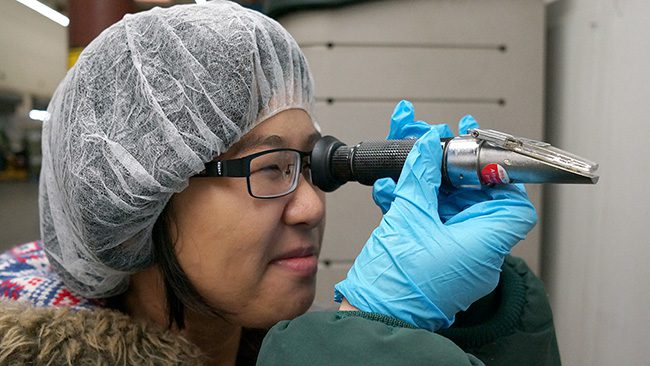Have you ever wondered how my company, Frieda’s, knows when fruit is ripe and sweet? Well, today was a good reminder for me on just how we do that.
Over the New Year’s holiday, my husband and I had friends visiting from Houston, and before they left, they stopped by my office for a quick tour.
After a visit in the offices, we donned our hairnets, sanitized our hands and put on our gloves—all requirements for our facility.
We walked through the repacking area where large boxes of products are repacked into smaller ones. For example, we might receive a box of 40-pound Habanero Chile Peppers, which we will repack into 5-pound and 10-pound cartons. My friends were fascinated with the large number of projects we were working on at one time.
After we visited the receiving area which opens at 4 a.m. each day, we stopped by the Quality Assurance (QA) inspection station. Our QA Supervisor Nicole had prepped the area with some samples of tropical fruits: Cherimoya, Dragon Fruit, Gold Kiwifruit and Horned Melons (also known as Kiwano®).
It was fun to watch Nicole demonstrate the use of a refractometer which assists her in determining the ripeness and sweetness of fruit. The device measures the amount of soluble solids—the ratio of sugar to acid—in the fruit being evaluated. The measurement is also referred to as the Degree Brix or just Brix.

It was so interesting to see the difference in Brix of the Golden Kiwifruit, which was 13.5 percent to the Horned Melon which was a 4 percent. It kind of makes sense because the Horned Melon is a member of the Cucumber family, so we would not expect it to be sweet.

You can see that Nicole squeezes the juice from the fruit, right onto the open refractometer, and then closes it. She looks through the lens and the Degree Brix is reflected through the prism of the refractometer.


In case you are wondering, most supermarket produce warehouses have similar equipment and we ask them for their expectations before we ship to them. That’s why we test all our produce, before we receive it at our warehouse.
I don’t think you will ever find a refractometer at an actual grocery store, as it is a very expensive piece of equipment, close to $500. But if you have some time, check out this YouTube video on how to use one!
As you can see, sometimes picking a ripe piece of fruit is not as easy as squeezing a cantaloupe or smelling a strawberry! My friends were very happy to have learned something new.

Karen





